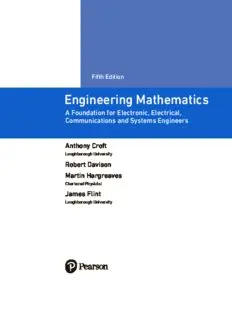Table Of ContentFifth Edition
Engineering Mathematics
A Foundation for Electronic, Electrical,
Communications and Systems Engineers
Anthony Croft
LoughboroughUniversity
Robert Davison
Martin Hargreaves
CharteredPhysicist
James Flint
LoughboroughUniversity
PEARSONEDUCATIONLIMITED
EdinburghGate
HarlowCM202JE
UnitedKingdom
Tel:+44(0)1279623623
Web:www.pearson.com/uk
FirsteditionpublishedundertheAddison-Wesleyimprint1992(print)
SecondeditionpublishedundertheAddison-Wesleyimprint1996(print)
ThirdeditionpublishedunderthePrenticeHallimprint2001(print)
Fourtheditionpublished2013(printandelectronic)
Fiftheditionpublished2017(printandelectronic)
©Addison-WesleyPublishersLimited1992,1996(print)
©PearsonEducationLimited2001(print)
©PearsonEducationLimited2013,2017(printandelectronic)
PearsonEducationisnotresponsibleforthecontentofthird-partyinternetsites.
ISBN:978-1-292-14665-2(print)
978-1-292-14667-6(PDF)
978-1-292-14666-9(ePub)
BritishLibraryCataloguing-in-PublicationData
AcataloguerecordfortheprinteditionisavailablefromtheBritishLibrary
LibraryofCongressCataloging-in-PublicationData
Names:Croft,Tony,1957–author.
Title:Engineeringmathematics:afoundationforelectronic,electrical,
communicationsandsystemsengineers/AnthonyCroft,Loughborough
University,RobertDavison,DeMontfortUniversity,MartinHargreaves,
DeMontfortUniversity,JamesFlint,LoughboroughUniversity.
Description:Fifthedition.|Harlow,England;NewYork:Pearson,2017.k
Revisededitionof:Engineeringmathematics:afoundationforelectronic,
electrical,communications,andsystemsengineers/AnthonyCroft,Robert
Davison,MartinHargreaves.3rdediton.2001.|Includesindex.
Identifiers:LCCN2017011081|ISBN9781292146652(Print)|ISBN9781292146676
(PDF)|ISBN9781292146669(ePub)
Subjects:LCSH:Engineeringmathematics.|Electrical
engineering–Mathematics.|Electronics–Mathematics.
Classification:LCCTA330.C762017|DDC510–dc23
LCrecordavailableathttps://lccn.loc.gov/2017011081
AcatalogrecordfortheprinteditionisavailablefromtheLibraryofCongress
Printeditiontypesetin10/12TimesRomanbyiEnerzigerAptara®,Ltd.
PrintedinSlovakiabyNeografia
NOTETHATANYPAGECROSSREFERENCESREFERTOTHEPRINTEDITION
Contents
Preface xvii
Acknowledgements xix
Chapter 1 Review of algebraic techniques
1
1.1 Introduction 1
1.2 Lawsofindices 2
1.3 Numberbases 11
1.4 Polynomialequations 20
1.5 Algebraicfractions 26
1.6 Solutionofinequalities 33
1.7 Partialfractions 39
1.8 Summationnotation 46
Reviewexercises1 50
Chapter 2 Engineering functions
54
2.1 Introduction 54
2.2 Numbersandintervals 55
2.3 Basicconceptsoffunctions 56
2.4 Reviewofsomecommonengineeringfunctionsandtechniques 70
Reviewexercises2 113
Chapter 3 The trigonometric functions
115
3.1 Introduction 115
3.2 Degreesandradians 116
3.3 Thetrigonometricratios 116
3.4 Thesine,cosineandtangentfunctions 120
3.5 Thesincxfunction 123
3.6 Trigonometricidentities 125
3.7 Modellingwavesusingsint andcost 131
3.8 Trigonometricequations 144
Reviewexercises3 150
Chapter 4 Coordinate systems
154
4.1 Introduction 154
4.2 Cartesiancoordinatesystem–twodimensions 154
4.3 Cartesiancoordinatesystem–threedimensions 157
4.4 Polarcoordinates 159
4.5 Somesimplepolarcurves 163
4.6 Cylindricalpolarcoordinates 166
4.7 Sphericalpolarcoordinates 170
Reviewexercises4 173
Chapter 5 Discrete mathematics
175
5.1 Introduction 175
5.2 Settheory 175
5.3 Logic 183
5.4 Booleanalgebra 185
Reviewexercises5 197
Chapter 6 Sequences and series
200
6.1 Introduction 200
6.2 Sequences 201
6.3 Series 209
6.4 Thebinomialtheorem 214
6.5 Powerseries 218
6.6 Sequencesarisingfromtheiterativesolution
ofnon-linearequations 219
Reviewexercises6 222
Chapter 7 Vectors
224
7.1 Introduction 224
7.2 Vectorsandscalars:basicconcepts 224
7.3 Cartesiancomponents 232
7.4 Scalarfieldsandvectorfields 240
7.5 Thescalarproduct 241
7.6 Thevectorproduct 246
7.7 Vectorsofndimensions 253
Reviewexercises7 255
Chapter 8 Matrix algebra
257
8.1 Introduction 257
8.2 Basicdefinitions 258
8.3 Addition,subtractionandmultiplication 259
8.4 Usingmatricesinthetranslationandrotationofvectors 267
8.5 Somespecialmatrices 271
8.6 Theinverseofa2×2matrix 274
8.7 Determinants 278
8.8 Theinverseofa3×3matrix 281
8.9 Applicationtothesolutionofsimultaneousequations 283
8.10 Gaussianelimination 286
8.11 Eigenvaluesandeigenvectors 294
8.12 Analysisofelectricalnetworks 307
8.13 Iterativetechniquesforthesolutionofsimultaneousequations 312
8.14 Computersolutionsofmatrixproblems 319
Reviewexercises8 321
Chapter 9 Complex numbers
324
9.1 Introduction 324
9.2 Complexnumbers 325
9.3 Operationswithcomplexnumbers 328
9.4 Graphicalrepresentationofcomplexnumbers 332
9.5 Polarformofacomplexnumber 333
9.6 Vectorsandcomplexnumbers 336
9.7 Theexponentialformofacomplexnumber 337
9.8 Phasors 340
9.9 DeMoivre’stheorem 344
9.10 Lociandregionsofthecomplexplane 351
Reviewexercises9 354
Chapter 10 Differentiation
356
10.1 Introduction 356
10.2 Graphicalapproachtodifferentiation 357
10.3 Limitsandcontinuity 358
10.4 Rateofchangeataspecificpoint 362
10.5 Rateofchangeatageneralpoint 364
10.6 Existenceofderivatives 370
10.7 Commonderivatives 372
10.8 Differentiationasalinearoperator 375
Reviewexercises10 385
Chapter 11 Techniques of differentiation
386
11.1 Introduction 386
11.2 Rulesofdifferentiation 386
11.3 Parametric,implicitandlogarithmicdifferentiation 393
11.4 Higherderivatives 400
Reviewexercises11 404
Chapter 12 Applications of differentiation
406
12.1 Introduction 406
12.2 Maximumpointsandminimumpoints 406
12.3 Pointsofinflexion 415
12.4 TheNewton–Raphsonmethodforsolvingequations 418
12.5 Differentiationofvectors 423
Reviewexercises12 427
Chapter 13 Integration
428
13.1 Introduction 428
13.2 Elementaryintegration 429
13.3 Definiteandindefiniteintegrals 442
Reviewexercises13 453
Chapter 14 Techniques of integration
457
14.1 Introduction 457
14.2 Integrationbyparts 457
14.3 Integrationbysubstitution 463
14.4 Integrationusingpartialfractions 466
Reviewexercises14 468
Chapter 15 Applications of integration
471
15.1 Introduction 471
15.2 Averagevalueofafunction 471
15.3 Rootmeansquarevalueofafunction 475
Reviewexercises15 479
Chapter 16 Further topics in integration
480
16.1 Introduction 480
16.2 Orthogonalfunctions 480
16.3 Improperintegrals 483
16.4 Integralpropertiesofthedeltafunction 489
16.5 Integrationofpiecewisecontinuousfunctions 491
16.6 Integrationofvectors 493
Reviewexercises16 494
Chapter 17 Numerical integration
496
17.1 Introduction 496
17.2 Trapeziumrule 496
17.3 Simpson’srule 500
Reviewexercises17 505
Chapter 18 Taylor polynomials, Taylor series and Maclaurin series
507
18.1 Introduction 507
18.2 Linearizationusingfirst-orderTaylorpolynomials 508
18.3 Second-orderTaylorpolynomials 513
18.4 Taylorpolynomialsofthenthorder 517
18.5 Taylor’sformulaandtheremainderterm 521
18.6 TaylorandMaclaurinseries 524
Reviewexercises18 532
Chapter 19 Ordinary differential equations I
534
19.1 Introduction 534
19.2 Basicdefinitions 535
19.3 First-orderequations:simpleequationsandseparation
ofvariables 540
19.4 First-orderlinearequations:useofanintegratingfactor 547
19.5 Second-orderlinearequations 558
19.6 Constantcoefficientequations 560
19.7 Seriessolutionofdifferentialequations 584
19.8 Bessel’sequationandBesselfunctions 587
Reviewexercises19 601
Chapter 20 Ordinary differential equations II
603
20.1 Introduction 603
20.2 Analoguesimulation 603
20.3 Higherorderequations 606
20.4 State-spacemodels 609
20.5 Numericalmethods 615
20.6 Euler’smethod 616
20.7 ImprovedEulermethod 620
20.8 Runge–Kuttamethodoforder4 623
Reviewexercises20 626
Chapter 21 The Laplace transform
627
21.1 Introduction 627
21.2 DefinitionoftheLaplacetransform 628
21.3 Laplacetransformsofsomecommonfunctions 629
21.4 PropertiesoftheLaplacetransform 631
21.5 Laplacetransformofderivativesandintegrals 635
21.6 InverseLaplacetransforms 638
21.7 UsingpartialfractionstofindtheinverseLaplacetransform 641
21.8 FindingtheinverseLaplacetransformusingcomplexnumbers 643
21.9 Theconvolutiontheorem 647
21.10Solvinglinearconstantcoefficientdifferential
equationsusingtheLaplacetransform 649
21.11Transferfunctions 659
21.12Poles,zerosandthesplane 668
21.13Laplacetransformsofsomespecialfunctions 675
Reviewexercises21 678
Chapter 22 Difference equations and the z transform
681
22.1 Introduction 681
22.2 Basicdefinitions 682
22.3 Rewritingdifferenceequations 686
22.4 Blockdiagramrepresentationofdifferenceequations 688
22.5 Designofadiscrete-timecontroller 693
22.6 Numericalsolutionofdifferenceequations 695
22.7 Definitionoftheztransform 698
22.8 Samplingacontinuoussignal 702
22.9 Therelationshipbetweentheztransformandthe
Laplacetransform 704
22.10Propertiesoftheztransform 709
22.11Inversionofztransforms 715
22.12Theztransformanddifferenceequations 718
Reviewexercises22 720
Chapter 23 Fourier series
722
23.1 Introduction 722
23.2 Periodicwaveforms 723
23.3 Oddandevenfunctions 726
23.4 Orthogonalityrelationsandotherusefulidentities 732
23.5 Fourierseries 733
23.6 Half-rangeseries 745
23.7 Parseval’stheorem 748
23.8 Complexnotation 749
23.9 Frequencyresponseofalinearsystem 751
Reviewexercises23 755
Chapter 24 The Fourier transform
757
24.1 Introduction 757
24.2 TheFouriertransform–definitions 758
24.3 SomepropertiesoftheFouriertransform 761
24.4 Spectra 766
24.5 Thet−ωdualityprinciple 768
24.6 Fouriertransformsofsomespecialfunctions 770
24.7 TherelationshipbetweentheFouriertransform
andtheLaplacetransform 772
24.8 Convolutionandcorrelation 774
24.9 ThediscreteFouriertransform 783
24.10Derivationofthed.f.t. 787
24.11Usingthed.f.t.toestimateaFouriertransform 790
24.12Matrixrepresentationofthed.f.t. 792
24.13Somepropertiesofthed.f.t. 793
24.14Thediscretecosinetransform 795
24.15Discreteconvolutionandcorrelation 801
Reviewexercises24 821
Chapter 25 Functions of several variables
823
25.1 Introduction 823
25.2 Functionsofmorethanonevariable 823
25.3 Partialderivatives 825
25.4 Higherorderderivatives 829
25.5 Partialdifferentialequations 832
25.6 TaylorpolynomialsandTaylorseriesintwovariables 835
25.7 Maximumandminimumpointsofafunctionoftwovariables 841
Reviewexercises25 846
Chapter 26 Vector calculus
849
26.1 Introduction 849
26.2 Partialdifferentiationofvectors 849
26.3 Thegradientofascalarfield 851
26.4 Thedivergenceofavectorfield 856
26.5 Thecurlofavectorfield 859
26.6 Combiningtheoperatorsgrad,divandcurl 861
26.7 Vectorcalculusandelectromagnetism 864
Reviewexercises26 865
Chapter 27 Line integrals and multiple integrals
867
27.1 Introduction 867
27.2 Lineintegrals 867
27.3 Evaluationoflineintegralsintwodimensions 871
27.4 Evaluationoflineintegralsinthreedimensions 873
27.5 Conservativefieldsandpotentialfunctions 875
27.6 Doubleandtripleintegrals 880
27.7 Somesimplevolumeandsurfaceintegrals 889
27.8 ThedivergencetheoremandStokes’theorem 895
27.9 Maxwell’sequationsinintegralform 899
Reviewexercises27 901
Chapter 28 Probability
903
28.1 Introduction 903
28.2 Introducingprobability 904
28.3 Mutuallyexclusiveevents:theadditionlawofprobability 909
28.4 Complementaryevents 913
28.5 Conceptsfromcommunicationtheory 915
28.6 Conditionalprobability:themultiplicationlaw 919
28.7 Independentevents 925
Reviewexercises28 930
Chapter 29 Statistics and probability distributions
933
29.1 Introduction 933
29.2 Randomvariables 934
29.3 Probabilitydistributions–discretevariable 935
29.4 Probabilitydensityfunctions–continuousvariable 936
29.5 Meanvalue 938
29.6 Standarddeviation 941
29.7 Expectedvalueofarandomvariable 943
29.8 Standarddeviationofarandomvariable 946
29.9 Permutationsandcombinations 948
29.10Thebinomialdistribution 953
29.11ThePoissondistribution 957
29.12Theuniformdistribution 961
29.13Theexponentialdistribution 962
29.14Thenormaldistribution 963
29.15Reliabilityengineering 970
Reviewexercises29 977

